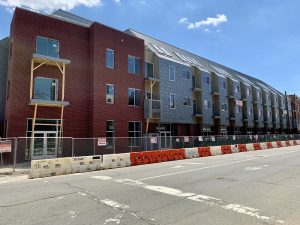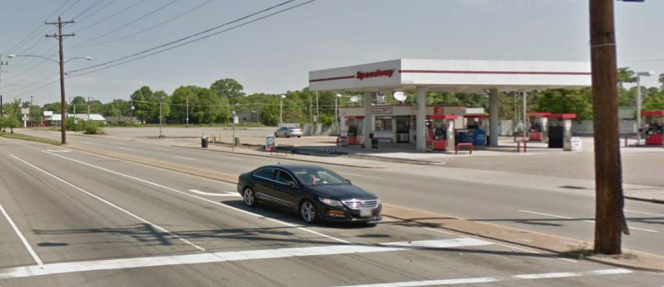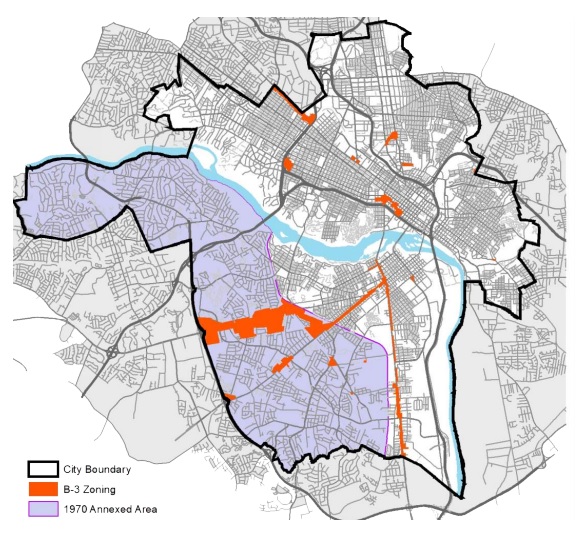As an update to Richmond’s master land-use plan continues, a separate but related effort to redefine a business zoning district found primarily in the city’s Southside is likewise moving forward, despite reservations from residents of a neighborhood on the opposite side of the river.
The Richmond Planning Commission on Monday adopted a pair of resolutions declaring the city’s intent to amend its B-3 General Business zoning district, found in areas across the city but mainly along commercial corridors in the Southside such as Midlothian Turnpike, Hull Street and Jefferson Davis Highway.
The changes would move away from the large street-fronting parking lots and building setbacks that define those corridors, parts of which make up the bulk of B-3 zoning in the city. They also would prohibit or restrict certain businesses considered incompatible with neighboring residential areas, such as adult entertainment and so-called predatory lending businesses.

The changes would discourage large parking lots like this one at Southside Plaza. (City of Richmond photo)
The amendment stems from a request from City Councilmember Michael Jones, who, in asking for a study of the district two years ago, maintained that the preponderance of B-3 south of the river is inequitable with other parts of the city. Jones represents Richmond’s Ninth District, which along with the neighboring Eighth District represents 82 percent of B-3 in the city combined, with 821 acres between the two districts.
Revising B-3, which planners describe as auto-oriented and outdated in light of current development trends, also is recommended in the draft Richmond 300 plan, an update to the city’s master plan that is headed for potential adoption this fall.
Monday’s intent declaration formally starts the B-3 amendment process, which would involve public hearings and review by the commission and City Council before the proposed changes could be approved.
The commission had been scheduled to make the declarations at its previous meeting in July, but held off due to concerns from residents of Oregon Hill, who argued that the changes would negatively affect the neighborhood due to a stretch of Cary Street that is zoned B-3. Concerns included proposed building heights that would be allowed along that stretch, between Cherry and Belvidere streets, that serves as a northern gateway to the neighborhood.

B-3 properties along Cary Street near Oregon Hill include the recently constructed 805W Lofts apartments, which replaced a row of smaller, older buildings. (BizSense file)
In response to those concerns, commission members directed planning staff to draw up a companion resolution to identify such areas in the B-3 district that do not fit the zoning and would need to be rezoned. That resolution likewise was adopted Monday.
Properties to be identified
Commissioners said those rezonings would need to take place concurrently with the B-3 amendment, rather than after the amendment as staff initially had proposed. Areas to be rezoned would be identified and prioritized before a formal proposal comes back to the commission.
Recommendations for new zonings essentially would follow the future land-use plan included in Richmond 300, which is being tweaked based on feedback received since the draft plan was rolled out in early June. The revised plan is scheduled to be presented to the commission in late September, with a recommendation to City Council to be made in early October.
That could cause more opposition from Oregon Hill, as the draft plan recommends including the area in a land use designation called neighborhood mixed-use, which envisions building heights of up to four stories, and taller in some places. The designation is designed for urban areas that are primarily residential but include some other uses, such as the corner shops and restaurants found in Oregon Hill.
But some residents have opposed the designation as well, contending in written responses to the draft Richmond 300 plan that the taller building heights would be inconsistent with the largely residential neighborhood, which is currently limited to heights of 35 feet, or three stories.
The companion resolution adopted Monday states that recommendations for properties to be changed from B-3 would vary depending on the area. At the commission’s July 20 meeting, Mark Olinger, the city’s planning director, said the stretch of Cary Street at Oregon Hill would require extra effort, considering past attempts at rezoning that have failed.
At the same time, the 15 acres along Cary Street that are zoned B-3 represent 1/100th of 1 percent of all B-3 zoning in the city, said Anne Darby, a city planner leading the amendment. While the rezonings resolution aims to address such special cases, she said the B-3 amendment is intended to update the zoning citywide, with a focus on facilitating and guiding development in the Southside in particular.
“The B-3 district has been problematic for a very long time,” Darby said at the July meeting. “In many ways, it is just throwing everything no one wants in their neighborhood into one district. The councilman’s point when he patroned this original resolution was that it isn’t equitable and it isn’t fair.
“Amending the district makes sense in many ways because we’re trying to ameliorate some of these effects on the neighborhoods adjacent to B-3 corridors on the Southside of the city. We also need to rezone where it is totally inappropriate for parcels to be zoned B-3,” she said. “I don’t think anyone believes that the parcels on Cary Street in question should be zoned B-3.”
Restrictions on some businesses

The intersection of Jefferson Davis Highway at Walmsley Boulevard visualizes what planners describe as an auto-oriented zoning district. (City of Richmond photo)
The amendment to B-3 is intended to remove uses considered incompatible with adjacent neighborhoods, improve aesthetics and walkability along primary corridors, and allow for higher density and the creation of a sense of place, according to a staff report.
The amendment would remove adult entertainment businesses as a permitted principal use in B-3 and would restrict so-called predatory lending businesses through buffering requirements. Adult entertainment businesses, such as adult book stores, adult motion picture theaters and massage parlors, would remain allowed in B-4 Central Business District, and in M-1 and M-2 industrial districts.
Permitted principal uses in B-3 would be expanded to include breweries, small manufacturing uses and dwelling units of any kind. Other changes would discourage parking lots, reduce building setbacks and decrease maximum signage limits.
Building height limits would not change, though staff mentioned potential restrictions of 35 feet. The district currently restricts buildings to 35 feet but allows for heights of up to 60 feet, or 5½ stories, in some cases.
At Monday’s meeting, Jones, the Ninth District representative, thanked staff for presenting the proposal, which would be formally introduced to the commission and council at a later date.
“I believe that this is moving in the right direction,” Jones said, adding that such changes “are never easy.”
“I know it was something that was to happen in line with what our planning calls for long term, and I know that this was something that could have been looked at years ago. It just hadn’t been,” he said. “Now, it’s just simply that time.”
The amendment and associated rezonings follow other initiatives that planning staff has taken to update zoning in various parts of the city. Last year, zoning changes to encourage denser development were approved for Monroe Ward and areas near Virginia Union University.
Planners also are continuing to roll out rezoning proposals related to the Pulse Corridor Plan, with the latest round of proposals focusing on land primarily north of Broad Street in and around the Carver and Newtowne West neighborhoods. The commission is slated to review those proposals at its Sept. 8 meeting after several deferrals since May.
Correction: An earlier version of this story incorrectly referred to the Richmond 300 neighborhood mixed-use designation as a new zoning classification. It is one of nine land use designations in the draft master plan that are intended to guide development and future zoning decisions.
As an update to Richmond’s master land-use plan continues, a separate but related effort to redefine a business zoning district found primarily in the city’s Southside is likewise moving forward, despite reservations from residents of a neighborhood on the opposite side of the river.
The Richmond Planning Commission on Monday adopted a pair of resolutions declaring the city’s intent to amend its B-3 General Business zoning district, found in areas across the city but mainly along commercial corridors in the Southside such as Midlothian Turnpike, Hull Street and Jefferson Davis Highway.
The changes would move away from the large street-fronting parking lots and building setbacks that define those corridors, parts of which make up the bulk of B-3 zoning in the city. They also would prohibit or restrict certain businesses considered incompatible with neighboring residential areas, such as adult entertainment and so-called predatory lending businesses.

The changes would discourage large parking lots like this one at Southside Plaza. (City of Richmond photo)
The amendment stems from a request from City Councilmember Michael Jones, who, in asking for a study of the district two years ago, maintained that the preponderance of B-3 south of the river is inequitable with other parts of the city. Jones represents Richmond’s Ninth District, which along with the neighboring Eighth District represents 82 percent of B-3 in the city combined, with 821 acres between the two districts.
Revising B-3, which planners describe as auto-oriented and outdated in light of current development trends, also is recommended in the draft Richmond 300 plan, an update to the city’s master plan that is headed for potential adoption this fall.
Monday’s intent declaration formally starts the B-3 amendment process, which would involve public hearings and review by the commission and City Council before the proposed changes could be approved.
The commission had been scheduled to make the declarations at its previous meeting in July, but held off due to concerns from residents of Oregon Hill, who argued that the changes would negatively affect the neighborhood due to a stretch of Cary Street that is zoned B-3. Concerns included proposed building heights that would be allowed along that stretch, between Cherry and Belvidere streets, that serves as a northern gateway to the neighborhood.

B-3 properties along Cary Street near Oregon Hill include the recently constructed 805W Lofts apartments, which replaced a row of smaller, older buildings. (BizSense file)
In response to those concerns, commission members directed planning staff to draw up a companion resolution to identify such areas in the B-3 district that do not fit the zoning and would need to be rezoned. That resolution likewise was adopted Monday.
Properties to be identified
Commissioners said those rezonings would need to take place concurrently with the B-3 amendment, rather than after the amendment as staff initially had proposed. Areas to be rezoned would be identified and prioritized before a formal proposal comes back to the commission.
Recommendations for new zonings essentially would follow the future land-use plan included in Richmond 300, which is being tweaked based on feedback received since the draft plan was rolled out in early June. The revised plan is scheduled to be presented to the commission in late September, with a recommendation to City Council to be made in early October.
That could cause more opposition from Oregon Hill, as the draft plan recommends including the area in a land use designation called neighborhood mixed-use, which envisions building heights of up to four stories, and taller in some places. The designation is designed for urban areas that are primarily residential but include some other uses, such as the corner shops and restaurants found in Oregon Hill.
But some residents have opposed the designation as well, contending in written responses to the draft Richmond 300 plan that the taller building heights would be inconsistent with the largely residential neighborhood, which is currently limited to heights of 35 feet, or three stories.
The companion resolution adopted Monday states that recommendations for properties to be changed from B-3 would vary depending on the area. At the commission’s July 20 meeting, Mark Olinger, the city’s planning director, said the stretch of Cary Street at Oregon Hill would require extra effort, considering past attempts at rezoning that have failed.
At the same time, the 15 acres along Cary Street that are zoned B-3 represent 1/100th of 1 percent of all B-3 zoning in the city, said Anne Darby, a city planner leading the amendment. While the rezonings resolution aims to address such special cases, she said the B-3 amendment is intended to update the zoning citywide, with a focus on facilitating and guiding development in the Southside in particular.
“The B-3 district has been problematic for a very long time,” Darby said at the July meeting. “In many ways, it is just throwing everything no one wants in their neighborhood into one district. The councilman’s point when he patroned this original resolution was that it isn’t equitable and it isn’t fair.
“Amending the district makes sense in many ways because we’re trying to ameliorate some of these effects on the neighborhoods adjacent to B-3 corridors on the Southside of the city. We also need to rezone where it is totally inappropriate for parcels to be zoned B-3,” she said. “I don’t think anyone believes that the parcels on Cary Street in question should be zoned B-3.”
Restrictions on some businesses

The intersection of Jefferson Davis Highway at Walmsley Boulevard visualizes what planners describe as an auto-oriented zoning district. (City of Richmond photo)
The amendment to B-3 is intended to remove uses considered incompatible with adjacent neighborhoods, improve aesthetics and walkability along primary corridors, and allow for higher density and the creation of a sense of place, according to a staff report.
The amendment would remove adult entertainment businesses as a permitted principal use in B-3 and would restrict so-called predatory lending businesses through buffering requirements. Adult entertainment businesses, such as adult book stores, adult motion picture theaters and massage parlors, would remain allowed in B-4 Central Business District, and in M-1 and M-2 industrial districts.
Permitted principal uses in B-3 would be expanded to include breweries, small manufacturing uses and dwelling units of any kind. Other changes would discourage parking lots, reduce building setbacks and decrease maximum signage limits.
Building height limits would not change, though staff mentioned potential restrictions of 35 feet. The district currently restricts buildings to 35 feet but allows for heights of up to 60 feet, or 5½ stories, in some cases.
At Monday’s meeting, Jones, the Ninth District representative, thanked staff for presenting the proposal, which would be formally introduced to the commission and council at a later date.
“I believe that this is moving in the right direction,” Jones said, adding that such changes “are never easy.”
“I know it was something that was to happen in line with what our planning calls for long term, and I know that this was something that could have been looked at years ago. It just hadn’t been,” he said. “Now, it’s just simply that time.”
The amendment and associated rezonings follow other initiatives that planning staff has taken to update zoning in various parts of the city. Last year, zoning changes to encourage denser development were approved for Monroe Ward and areas near Virginia Union University.
Planners also are continuing to roll out rezoning proposals related to the Pulse Corridor Plan, with the latest round of proposals focusing on land primarily north of Broad Street in and around the Carver and Newtowne West neighborhoods. The commission is slated to review those proposals at its Sept. 8 meeting after several deferrals since May.
Correction: An earlier version of this story incorrectly referred to the Richmond 300 neighborhood mixed-use designation as a new zoning classification. It is one of nine land use designations in the draft master plan that are intended to guide development and future zoning decisions.

So, there is no mention of pawn shops, is there no fear of them? Isn’t what a pawn shop does equal to predatory lending?
Also, I’m really expecting the “adult business” and zoning stuff to come to a head over the strip clubs in Scott’s Addition.
Very sad as City planners vote for something that will allow the eventual ruin of my neighborhood, Oregon Hill, ignoring the pleas and vision of my neighbors in the process….
Not sure why Oregon Hill has not chosen to become a city old and historic district, it would offer more protections than complicated zoning fights. An argument that a four story modern building doesn’t fit because the neighborhood is mostly three stories feels more NIMBY than arguing that craftsmen built a cohesive 2-3 story neighborhood 120 years ago.
Not easy to get consensus among residents and many absentee landlords. But City staff also strung neighborhood leaders along by telling them that they could get a ‘no demolition’ overlay put in place and then told them they could not. Let’s not forget that the VCU administration still covets the neighborhood and SHAMEFULLY refuses to create a written agreement. We see how their ‘public relations’ shills post here. It’s not like neighborhood leaders have been siting on their hands- they have been trying to get the City and VCU to work with the neighborhood for literally decades.
The current city strategy is to encourage the construction of apartment buildings, usually consisting of one-bedroom and studio units. Whether intentional or not, they’re promoting the growth of a largely transient population over longtime home owners like myself. What the city really needs now is folks who will put down roots and raise families and take pride in their neighborhoods.
Good to hear they are continuing to tweak and move forward. This is long overdue! Looking at that Southside Plaza asphalt ocean, you can easily see how it could become a walkable, grid-based mixed-use neighborhood.
That map is outdated. The B-3 areas in Monroe Ward and Chamberlayne neighborhoods have both been reclassified.
Also, ‘residential mixed use’ is not a zoning classification per the article.It is a future land use designation under the Future Land Use Map planning tool meant to guide any future rezoning or special use permits> The significance being it is separate from the legally binding zoning classifications and does not automatically imply any zoning code as adopted.
The City is actively working with developers while withholding information from neighborhood. From Laurel Street neighbor Charles Pool: Dear Mr. Olinger, Could you please provide what information and plans that you have on development plans for property on West Cary Street within the B-3 zoning in the Oregon Hill Historic District on West Cary Street? It has come to light due to a belated FOIA response from the city that a developer has property under contract within the B-3 zoning on West Cary Street within the Oregon Hill Historic District: “From: Jennifer Mullen [mailto:[email protected]] Sent: Monday, July 6, 2020 8:05… Read more »